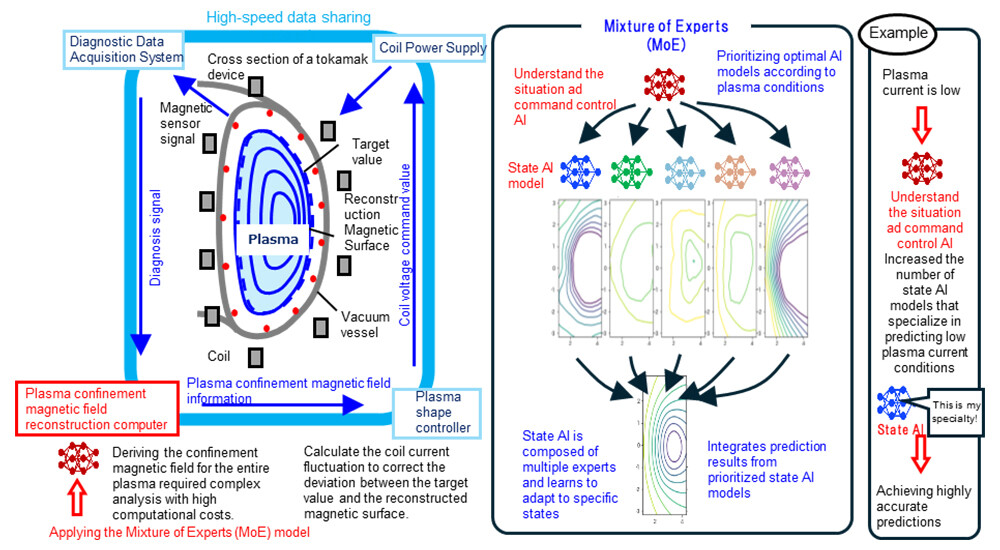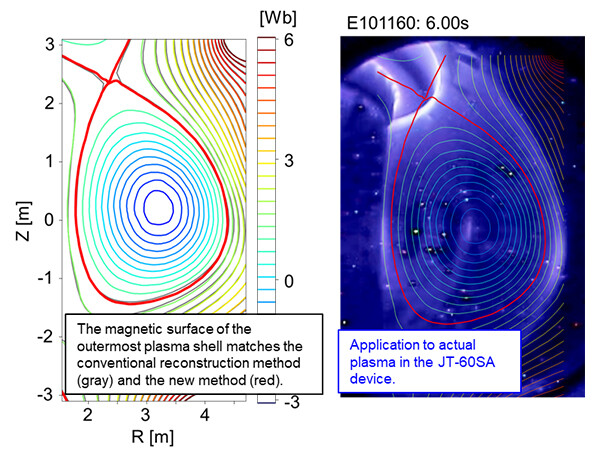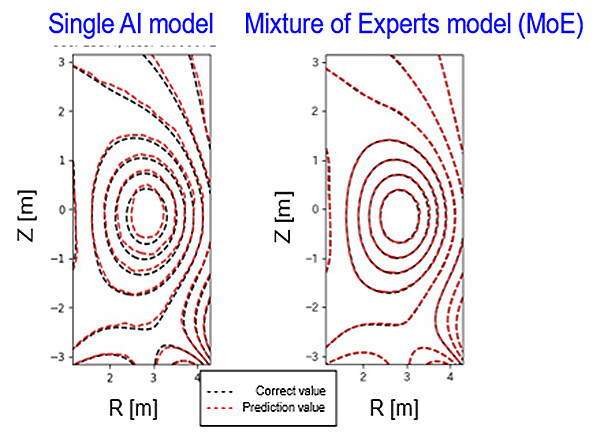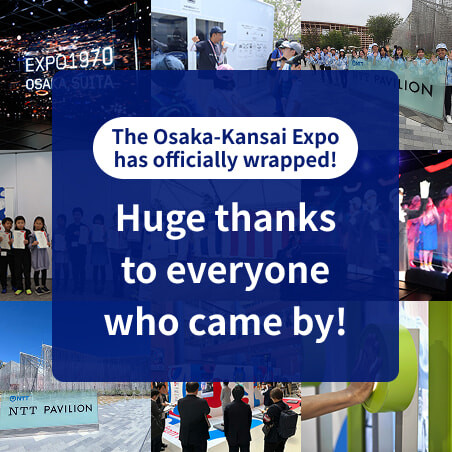Microsoft ends support for Internet Explorer on June 16, 2022.
We recommend using one of the browsers listed below.
- Microsoft Edge(Latest version)
- Mozilla Firefox(Latest version)
- Google Chrome(Latest version)
- Apple Safari(Latest version)
Please contact your browser provider for download and installation instructions.
March 17, 2025
National Institutes for Quantum Science and Technology
NTT Corporation
World's First Application of Highly Accurate AI Technology to Predict Plasma Confinement Magnetic Fields in Large-Scale Fusion Devices
~ QST and NTT Joint Research Achievements Advanced the Practical Application of Innovative Technology ~
News Highlights:
- We developed a method to predict the plasma confinement magnetic field of a fusion device using multiple AIs. We applied this to the tokamak-type superconducting plasma experimental device JT-60SA and were able to accurately reproduce the position and shape of the plasma, and explored the potential of AI utilization for plasma prediction with rapidly changing conditions.
- The achievements of the joint research conducted on plasma prediction technology using AI under the collaboration agreement between QST and NTT are expected to be implemented in JT-60SA. We will further strengthen our collaboration and contribute to the advancement of innovative environmental energy technologies.
The National Institutes for Quantum and Science and Technology (QST, President: Shigeo Koyasu) and NTT Corporation (NTT, President and CEO: Akira Shimada) have established an AI prediction method to be applied to plasma confinement magnetic fields of large-scale fusion devices.
QST and NTT signed a collaboration agreement*1 in 2020 and have been conducting joint research aimed at creating world-leading, innovative environmental energy technologies.
This time, a Mixture of Experts (MoE)*2 method which weights and integrates the most appropriate AI models according to the sequentially changing situation, has been applied to establish a technology for controlling plasma with high precision, and evaluated the actual plasma confinement magnetic field of the world's largest tokamak*3 type superconducting plasma experimental device, JT-60SA*4. As a result, we succeeded for the first time in the world in reproducing the position and shape of the plasma, which depend on the magnetic field structure, with the precision required for actual plasma control. Conventional analytical reconstruction methods*5 based on the laws of physics were in principle capable of controlling the position and shape of the plasma boundary, which changes sequentially. However, with this method, we have obtained the prospect of controlling multiple control quantities in real time, including the distribution of current and pressure inside the plasma, which is important for avoiding plasma instability, which was not possible with conventional methods.
This achievement will be useful in challenging the real-time control of high-temperature plasma in future heating experiments on JT-60SA and is also a groundbreaking achievement that will lead to predictive control of plasma in fusion reactors such as ITER*6 and DEMO*7, which control larger plasmas with fewer instruments. As a result of this achievement, QST and NTT have agreed to further extend the collaborative agreement they signed in 2020 and will continue to work together toward the early practical application of fusion energy.
 Panoramic view of JT-60SA
Panoramic view of JT-60SA
1. Background
Tokamak, which is the world's most advanced towards DEMO reactor for fusion energy, an innovative form of environmental energy, requires a continuous flow of electric current in the plasma because the plasma itself forms a confinement magnetic field. However, this current and plasma pressure can cause instabilities. To establish a stable DEMO reactor, these instabilities must be predicted ahead of time and controlled properly. The challenge was to find a way to reconstruct the plasma confinement magnetic field needed for control in real time and with high accuracy from measurement signals. As one solution, this joint research has created a method to accurately evaluate the plasma confinement magnetic field using AI technology that solves optimization problems. The goal is to utilize this method to control the JT-60SA, which is the world's largest tokamak-type superconducting plasma experiment device.
2. Research Methods and Achievements
The plasma confinement magnetic field is controlled by first reconstructing the plasma confinement magnetic field from the signals of the measuring instruments attached to the vacuum vessel, then calculating the difference in the coil current to generate the magnetic field necessary to correct the deviation between the reconstruction result and the target value, and sending a command to the coil power supply (Figure 1). Conventional plasma confinement magnetic field reconstruction has the problem that it requires step-by-step process to solve complex equations with many calculations according to physics laws. So, we've been working on a way to use AI to estimate the confinement magnetic field from the measurement signal information with just one calculation, without having to use the laws of physics. However, a single AI model could not meet the required accuracy for predicting the plasma confinement magnetic field in a transient state where the plasma changes from moment to moment.
Therefore, we developed a method to evaluate the plasma confinement magnetic field using an AI model optimized according to the sequentially changing plasma conditions while appropriately prioritizing the state AI model called Mixture of Experts (MoE), which has multiple state understanding and command control AIs (currently patent pending). As a result of evaluating this method with the actual plasma confinement magnetic field in JT-60SA, we succeeded for the first time in the world in reproducing the plasma position shape accuracy (up to 1 cm, the world's highest precision, which is about 1% of the world's largest plasma) required for plasma control using AI without performing complex calculations step by step (Figure 2). In particular, under conditions where the current flowing in the plasma is not steady but fluctuating, the reconstruction accuracy of the plasma confinement magnetic field decreases with a single AI model. However, by using the MoE method, the state understanding and command control AI can appropriately prioritize the state AI models, making it possible to accurately evaluate the plasma confinement magnetic field even in such transient conditions (Figure 3).
In theory, the conventional method*5 can only change the position and shape of the plasma boundary. This MoE method, on the other hand, could let us change the current and pressure distribution inside the plasma in real time, which is important to keep the plasma from becoming unstable.
 Figure 1 A series of steps for plasma confinement magnetic field control (left). The Mixture of Expert (MoE) weights the AI model according to the plasma state and evaluates it with the most suitable model (right).
Figure 1 A series of steps for plasma confinement magnetic field control (left). The Mixture of Expert (MoE) weights the AI model according to the plasma state and evaluates it with the most suitable model (right).
 Figure 2 magnetic surfaces of the plasma boundary match between the conventional reconstruction method and the MoE method (left). In principle, the conventional method cannot reconstruct the plasma interior. We applied the MoE method to the actual plasma of JT-60SA to evaluate its validity (right).
Figure 2 magnetic surfaces of the plasma boundary match between the conventional reconstruction method and the MoE method (left). In principle, the conventional method cannot reconstruct the plasma interior. We applied the MoE method to the actual plasma of JT-60SA to evaluate its validity (right).
 Figure 3 When the current flowing through the plasma changes, the accuracy of the plasma confinement magnetic field evaluation decreases when using a single AI model optimized overall (left). By using the MoE method, the AI model is optimized under various conditions and the plasma confinement magnetic field is evaluated with high accuracy (right).
Figure 3 When the current flowing through the plasma changes, the accuracy of the plasma confinement magnetic field evaluation decreases when using a single AI model optimized overall (left). By using the MoE method, the AI model is optimized under various conditions and the plasma confinement magnetic field is evaluated with high accuracy (right).
3. Roles of each company
- QST: Design of logic based on knowledge of plasma control, provision of physical analysis code, and application to JT-60SA actual data
- NTT: AI technology proposal, model design
4. Outlook
This achievement is effective in challenging the real-time control of high-temperature plasma in future heating experiments on JT-60SA, and is also a groundbreaking achievement that will lead to predictive plasma control in fusion reactors such as ITER and DEMO, which control larger plasmas with a small number of measuring instruments. In response to this achievement, QST and NTT have agreed to further extend the collaboration agreement signed in 2020, and will continue to work together toward the early practical application of fusion energy, applying NTT's advanced technologies, including the IOWN concept*8, to fusion research and development.
【Glossary】
*1Details of the Collaboration Agreement between NTT and QST
https://www.qst.go.jp/site/press/45578.html (Japanese)
https://group.ntt/jp/newsrelease/2020/11/06/201106a.html (Japanese)
*2Mixture of Experts; MoE
This approach combines multiple expert models to provide optimal solutions to specific problems in machine learning. By weighting the output of each expert model according to the input data, the predictions of the AI models are integrated and optimized according to the situation. It has the characteristic of being able to perform better than a single model.
*3Tokamak
A method of confining high-temperature plasma using a magnetic field: A high-temperature plasma is confined by combining a circumferential toroidal magnetic field produced by the external coils, which is the main magnetic field, with a radial poloidal magnetic field created by passing a circumferential current in the plasma. ITER also uses a tokamak-type device.
*4JT-60SA (JT-60 Super Advanced)
As a joint project of the satellite tokamak project jointly implemented by Japan and Europe as a Broader Approach (BA) activity and the tokamak domestic priority device project that has been under consideration in Japan, the device was constructed at the QST facility in Naka City, Ibaraki Prefecture, Japan. This is the world's largest tokamak-type superconducting plasma experimental device as of today. Its purpose is to support research for ITER to achieve its technological goals and supplementary research for ITER toward DEMO reactors and human resource development. JT-60SA uses powerful superconducting coils cooled to approximately -269 Celsius (absolute temperature approximately 4K) to confine plasma that can reach 100 million degrees of temperature.
URL: https://www.qst.go.jp/site/jt60/5150.html (Japanese)
*5Conventional Analytical Reconstruction Method
It uses the signal from the measuring device outside the plasma and the current in the coil to guess the shape of the plasma cross-section. This method is called the Cauchy Condition Surface (CCS) method. It is possible to put a virtual surface inside the plasma that acts like the plasma current and get information about its magnetic field (Cauchy condition). This is done so that the magnetic field information provided by the virtual surface at the position of the measuring instrument matches the value that was measured. This method is characterized by its ability to estimate the plasma position shape with high accuracy. However, theoretically, this method is unable to estimate the distribution of magnetic fields, currents, and pressures within the plasma.
*6ITER Project
With the international cooperation of seven Parties: Japan, Europe, Russia, the United States, China, Korea, and India—the project is to demonstrate the scientific and technological feasibility of fusion energy through the construction and operation of ITER. The target of the project is to obtain the fusion energy 10 times larger than the input energy of the external heating system (Q≧10). Currently, the site is in Saint-Paul-les-Durance, France, and ITER Organization, an international organization for the project implementation, is leading the construction of buildings and the assembly of components for the start of operation. Also, the manufacturing of various ITER component devices has been advanced by each of the seven parties.
URL: https://www.fusion.qst.go.jp/ITER/ (Japanese)
*7DEMO Reactor
A DEMO reactor is a next-generation device that will be constructed based on the achievements of JT-60SA and ITER and will demonstrate the power generation and economic feasibility of fusion energy. Currently, conceptual designs for DEMO reactors are being developed in various countries around the world.
*8IOWN concept
The IOWN (Innovative Optical and Wireless Network) concept is a concept of a network and information processing infrastructure, including devices, capable of providing high-speed, high-capacity communications and enormous computing resources by optimizing individuals and the entire system based on all kinds of information and utilizing innovative technologies centered on optics. For details, please visit the following website.
■ What is the IOWN concept?
https://www.rd.ntt/e/iown/
Contact for inquiries regarding this matter
National Institutes for Quantum Science and technology
(About our research)
Takahiro Suzuki, Director of Department of Advanced Plasma Research,
Naka Institute for Fusion Science and Technology
Phone: 029-277-4294 E-mail: suzuki.takahiro@qst.go.jp
(Press coverage response)
International Affairs and Public Relations Section,
Department of International Affairs and Public Relations
Phone: 043-206-3026 E-mail: info@qst.go.jp
NTT Information Network Laboratory Group
Public Relations
Inquiry form
Information is current as of the date of issue of the individual press release.
Please be advised that information may be outdated after that point.
NTT STORY
WEB media that thinks about the future with NTT










